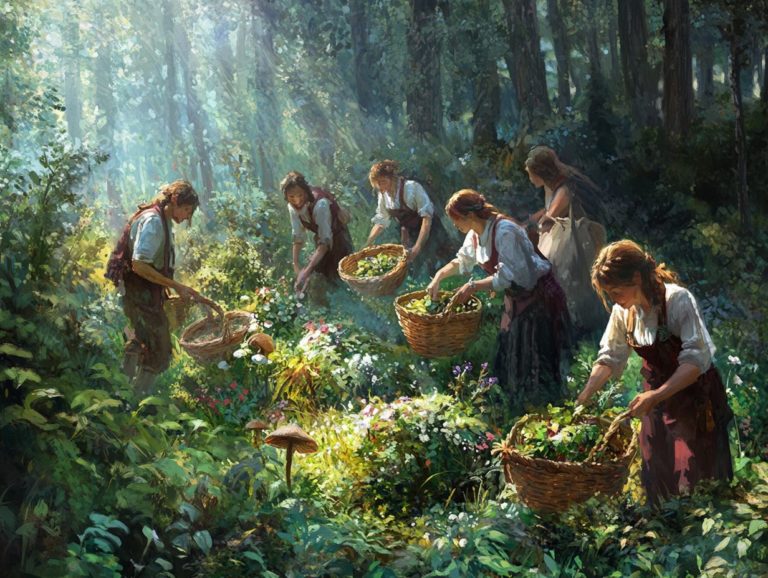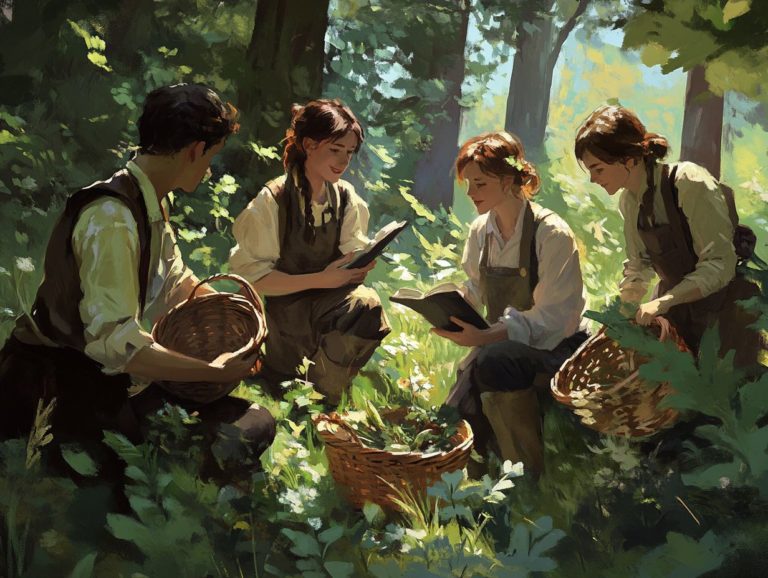How to Develop Your Own Foraging Techniques
Foraging is more than just a trend; it offers you a profound opportunity to reconnect with nature and tap into the rich bounty that the wild has to offer.
This guide will walk you through the essentials of foraging, from foundational techniques and necessary tools to identifying edible plants and fungi. You ll also delve into advanced methods like tracking and hunting, complete with invaluable tips for preserving your discoveries.
Safety and ethical considerations will be emphasized to ensure a responsible approach to this rewarding endeavor. You ll discover many physical and mental health benefits of foraging, while promoting sustainability and self-sufficiency.
Get ready to discover the secrets of the natural world and embark on a journey that enriches both body and mind.
Contents
- Key Takeaways:
- The Basics of Foraging
- Foraging Techniques for Beginners
- Advanced Foraging Techniques
- Foraging Safety and Ethics
- Benefits of Foraging
- Frequently Asked Questions
- What are foraging techniques that you can use?
- How can I develop my own foraging techniques?
- Do I need any special equipment for foraging?
- What are some common mistakes to avoid when developing foraging techniques?
- Can I forage in any season?
- Are there any safety precautions I should take when developing my own foraging techniques?
Key Takeaways:

- Learn the purpose of foraging to master effective techniques.
- Equip yourself with essential tools and knowledge to safely forage as a beginner.
- Advance your foraging skills by learning techniques such as tracking, hunting, and preserving foraged foods.
The Basics of Foraging
Foraging is the art of seeking out and gathering wild plants, mushrooms, and other natural edibles, serving both your nutritional needs and your sense of adventure. This ancient survival skill connects you deeply with nature while equipping you with the knowledge to identify a variety of wild edibles. To enhance your skills, check out how to master foraging in your region, from prickly pears to dandelions and morel mushrooms.
When you grasp the basics of foraging, you enable yourself to enjoy the bounty of the wild while ensuring your safety by recognizing hazardous plants like the Death Cap and Monkshood, which can pose serious health risks. By employing the universal edibility test, a simple method to check if a plant is safe to eat, you can confidently explore and relish the wonders of wild foods, all while keeping your well-being intact.
Why Foraging Matters
Understanding the practice and purpose of foraging requires you to recognize its historical roots in human survival and its modern significance in sourcing wild edibles.
For centuries, foraging has been an essential skill, connecting our ancestors intimately with the land. It provided them with vital nutrients while nurturing a profound respect for the environment.
Today, as you observe a renewed interest in sustainable living practices, this ancient technique is making a resurgence not merely as a means of sustenance, but as a pathway to reconnecting with nature and embracing practices like herbalism courses.
Many individuals share stories about their inaugural experiences gathering wild mushrooms or foraging for berries, often highlighting the tranquility of the great outdoors.
Statistics indicate that foraging can significantly lower food expenses, promoting a lifestyle that embraces biodiversity the variety of different plants and animals in the environment through the use of pine nuts, rose hips, and blackberries, while minimizing carbon footprints.
Foraging Techniques for Beginners
Foraging techniques for beginners are designed to equip you with the essential skills needed to confidently identify and gather wild edibles, from plants to mushrooms. You’ll also discover the essential tools that will enhance your foraging adventures, ensuring your excursions are both fruitful and enjoyable, especially when you learn how to integrate foraging techniques into your life.
Essential Tools and Equipment
Essential tools for your foraging adventures include a sturdy basket for gathering wild edibles, a reliable field guide for plant identification, and practical tools like a knife or trowel to assist in harvesting.
These items are crucial for efficiently collecting nature’s bounty and ensuring you’re well-prepared to navigate the intricate world of edible plants. A high-quality field guide, for example, becomes your essential companion, enabling you to confidently identify both common and rare species.
A well-crafted basket is key to preventing delicate plants from getting bruised or damaged during collection, ultimately enhancing your foraging experience. Additionally, you can elevate your foraging game with online resources, including a comprehensive guide on how to start foraging as a hobby, which provide identification guides, transforming each outing into an educational journey filled with exploration and discovery.
We invite you to share your foraging experiences or explore foraging locally to foster a sense of community and engagement.
Identifying Edible Plants and Fungi

Identifying edible plants and fungi, such as chickweed and chicken of the woods, is an essential skill in foraging. It requires a keen understanding of key characteristics to distinguish between safe and poisonous varieties.
Pay attention to specific traits like leaf shapes, growth patterns, and habitat. This will help you recognize plants like amaranth, known for its vibrant leaves and nutrient-rich seeds. For fungi, knowing the distinct features of varieties like chicken of the woods its striking yellow-orange color and shelf-like growth on trees can enhance your foraging success.
Prioritize safety; thorough research, consulting field guides, and seeking mentorship from experienced foragers can reduce the risks of misidentification. To learn more about sharing knowledge on this topic, check out how to spread awareness on foraging techniques. Follow this approach, and your foraging adventures will be rewarding and safe.
Advanced Foraging Techniques
Advanced foraging techniques elevate your experience, guiding you in the art of foraging for food in the wild. This knowledge enriches your ability to gather a diverse array of survival food and enhances your ability to take care of your food needs in the great outdoors.
Tracking and Hunting
Tracking and hunting as part of advanced foraging techniques enable you to understand animal behavior and gather meat from the wild. This enhances your survival skills.
Sharpen your ability to read the land, spot subtle signs of animal movement, and comprehend their seasonal habits. This knowledge boosts your self-sufficiency. It also fosters a deeper respect for wildlife and their ecosystems. Practicing ethical hunting ensures that the animals you harvest contribute sustainably to both the environment and your diet.
These skills beautifully complement plant and mushroom foraging. Both pursuits demand keen observation, patience, and a solid grasp of natural cycles. To enhance your skills further, consider exploring how to innovate traditional foraging techniques. This holistic approach to gathering sustenance enriches your connection to the natural world, making each foraging endeavor a rewarding experience.
Preserving and Preparing Foraged Foods
Preserving and preparing foraged foods involves techniques that ensure your edibles remain safe and flavorful for future enjoyment. This aligns perfectly with a sustainable approach to survival food.
Among the most favored methods are drying, fermenting, and pickling. Each method brings unique advantages and flavors to the table.
- Drying removes moisture, extends shelf life, and intensifies taste. It is ideal for herbs and fruits.
- Fermenting preserves and enhances nutritional value. It is perfect for greens like dandelion or wild garlic.
- Pickling adds a delightful tang, transforming wild vegetables into scrumptious condiments.
By exploring techniques like pickling and fermenting, you can maximize your foraged bounty. This ensures a variety of tastes throughout the year and fosters a deeper appreciation for nature’s offerings, including prickly pear and dandelion.
Foraging Safety and Ethics
Foraging safety and ethics are essential for you as an enthusiast. This allows you to appreciate the abundance of wild plants and mushrooms, like blackberries, while safeguarding both your well-being and the environment.
Start your foraging journey by exploring local parks or guided foraging tours.
Protecting Yourself and the Environment

Protecting yourself and the environment while foraging requires keen awareness of personal safety measures against poison ivy and the impact your practices have on local ecosystems.
Familiarize yourself with the identifying characteristics of local flora, especially those that are poisonous. This knowledge is your safeguard against accidental ingestion.
Consider adopting ethical guidelines that encourage sustainable practices. These include avoiding over-harvesting and respecting the nesting areas of local wildlife.
Being mindful of these factors enhances your safety and fosters the health of the natural surroundings. You create a harmonious balance between your foraging activities and the local ecosystem, making you a responsible steward of the outdoors.
Benefits of Foraging
Foraging offers an array of physical and mental health benefits that enhance your overall well-being while fostering sustainability and self-sufficiency.
Engaging in this practice cultivates a profound connection with nature, enriching your life and the environment around you through the discovery of wild edibles like rose hips.
Physical and Mental Health Benefits
Foraging provides a wealth of physical health benefits, giving you access to nutrient-rich wild edibles like chickweed and pine nuts. It also delivers notable mental health perks tied to immersing yourself in nature.
As you search for plants like dandelion greens or wild nettles, you elevate your nutritional intake and overall well-being. Research shows that simply being surrounded by greenery can lower cortisol levels the hormone linked to stress.
Many people report feeling significantly lighter in mood after spending time in natural settings.
Take wild berries, for example. Studies have demonstrated that plant compounds in these gems, such as elderberries, not only bolster immune health but also enhance your sense of happiness.
Interacting with nature whether through mindful foraging or simply relishing a tranquil landscape can lead to a meaningful reduction in anxiety, promoting a more balanced state of mental health.
Sustainability and Self-Sufficiency
Foraging nurtures sustainability and self-sufficiency, inviting you to harvest wild edibles responsibly while reducing your reliance on commercially produced food sources. Additionally, learning how to teach foraging techniques to kids can foster a deeper appreciation for nature in younger generations.
This practice enhances your personal well-being and nurtures local ecosystems. By focusing on biodiversity, you can play a crucial role in preserving native plant species and habitats.
As you learn to identify and cultivate various edible plants, deepen your knowledge of local flora and enrich your diet with diverse offerings.
By adhering to sustainable foraging principles like ensuring ample plants remain to regenerate and respecting wildlife habitats you foster a harmonious relationship with the environment.
Ultimately, embracing these mindful foraging practices enables you to make a positive contribution to your community and forge a deeper connection with nature.
Frequently Asked Questions
-
What are foraging techniques that you can use?
Foraging techniques are methods used to gather food from the wild. They are important because they allow you to safely and efficiently find and collect food in nature, as detailed in how to use foraging techniques in cooking.
-
How can I develop my own foraging techniques?
You can develop your foraging techniques by educating yourself on the types of plants and animals in your local area, as well as their edible and non-edible qualities. For more insights, learn how to innovate your foraging techniques and practice identifying and harvesting these resources sustainably.
-
Do I need any special equipment for foraging?
No, you do not necessarily need special equipment for foraging. However, a few essential items like a foraging knife or a sturdy basket may be helpful in your adventures.
What are some common mistakes to avoid when developing foraging techniques?
Avoid mistakes like misidentifying plants and animals. Always get permission to forage on private land and practice responsible foraging.
Can I forage in any season?
Absolutely! You can forage year-round. Just remember that the types of plants and animals vary with the seasons. Check what s available before you go!
Are there any safety precautions I should take when developing my own foraging techniques?
Yes, take safety seriously! Always identify plants and animals correctly. Wear the right clothes, and carry a first aid kit for emergencies.






